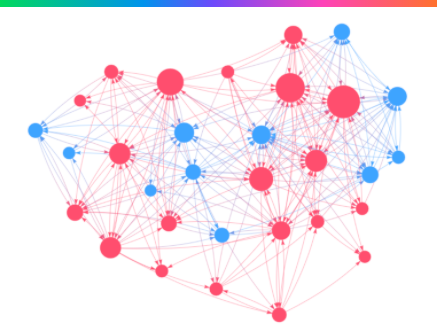Elevating Women in Technology
Giving women more visibility and helping them build strong networks through the power of technology helps create a culture of co-elevation and inclusiveness.
2020 has been an incredibly difficult year for people around the globe, particularly women, so much so that some economists say the setbacks they are facing will mark the first female recession.
In the case of women in technology, many are familiar with challenges such as the pay gap and lack of visibility for promotions already, often even accepting them as something that comes with their chosen career path. In part, it’s because men greatly outnumber women in the profession, which has often led to non-inclusive organizational cultures, making it more difficult for women to advance to management positions and, as a result, women leaving the profession at a significantly higher rate than men.
When you combine the unique challenges that 2020 has brought with the statistics of women in technology, it’s not surprising that so many of us feel the urgency to address these issues. The good news is that there are so many things we can do, as individuals and as organizations, to pave a more equitable path for women in the workplace, including those working in technology.
For example, at Globant, we have created a culture of co-elevation and support. How did we do it? We combined powerful diversity and inclusion initiatives, a strong culture technology platform, and people analytics. We are sharing our story with the hope that it will bring this community more ideas and optimism for the rest of the year and beyond.
Founded in 2003, Globant (NYSE: GLOB) is a digitally native company with over 12,500 employees in 16 countries. With a vast global presence and reach into many markets, a diverse and inclusive culture is fundamental to our continued success. It has driven us to develop and implement a variety of innovative and evolving D&I initiatives across the organization. To help further power its initiatives and be able to use people analytics to measure the strength of its culture, Globant built a technology platform called StarMeUp. From its earliest days, Globant’s founders wanted to make sure that no matter how big the company got every single person felt important and visible; like a founder. And so, for the last 13 years, StarMeUp has been the cornerstone of a strategy that has helped Globant build a very unique, and genuinely people-first culture.
In our most recent study, we found that not only do women have a lower overall turnover rate than men at Globant, but women also didn’t disproportionately leave during the months of the pandemic.
Because at Globant we are big believers that the key way for us to come out stronger from this global challenge is by joining together as a community, we wanted to share how we used a combination of a culture technology platform and people analytics to build an inclusive culture, especially for women in technology.

Visibility and Networks
There is a large body of research providing recommendations for what organizations can do to create a more inclusive environment for women in technology, as well as what women can focus on to be part of the change. In two of their recent articles, Harvard Business Review draws attention to giving women more visibility and helping them create a successful network.
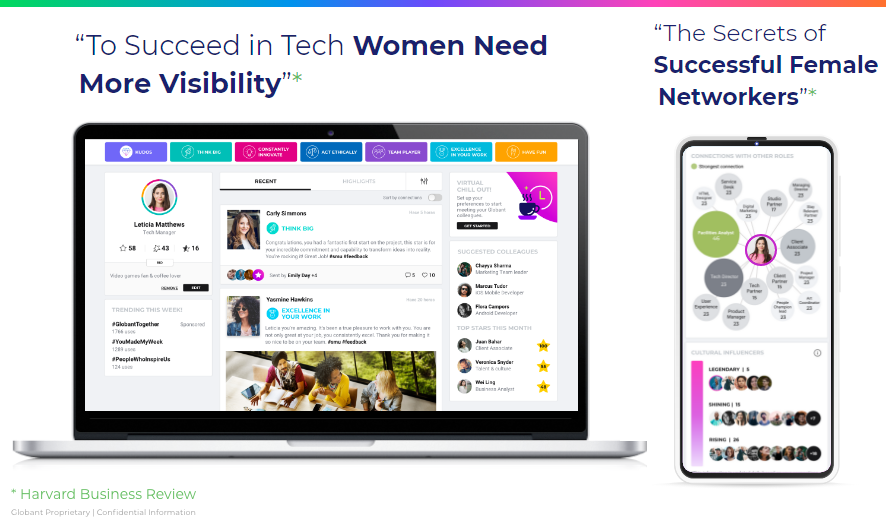
In StarMeUp, any employee in the organization can recognize another colleague for actions tied to one of the company’s core values. The recognition appears in real-time on the platform for everyone in the organization to see. Moreover, all employee networks are visible so employees can learn from the networks of the colleagues who they aspire to be like and see what has helped them stand apart. To best understand how Globant is giving women visibility and encouraging them to build a strong network, we looked at the data from StarMeUp analytics.
Connections that fuel growth
In studying the StarMeUp data to understand how employees connect (which we measure by the amount of recognition sent and received), we found that women at Globant have significantly larger networks than their male colleagues. Over the last year, women connected with 51% more colleagues than men, creating a greater breadth of connections.
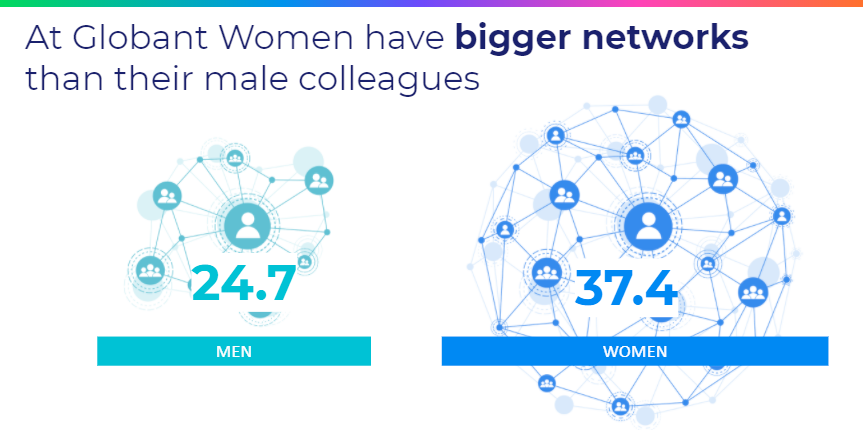
This finding was particularly encouraging because in an industry and company where men outnumber women we can affirm that women at Globant have significant exposure, visibility, and a level of comfort to build relationships across the organization. When it comes to having visibility and a healthy network—two key components in a more diverse and inclusive work environment—our data shows that we are on the right path.
Women co-elevating other women
Another challenge is that successful women will not always help other women on their career journey. Because they have often had to make sacrifices to achieve their professional goals, some women view this struggle as a right of passage that their female colleagues need to go through as well.
We found that this isn’t the case in Globant’s culture. In the last year, women had a greater number of other women in their network than men did (35.9% compared to 29.4%).

Additionally, we found that women give their colleagues more visibility than men do, recognizing others more, and, in turn, they become more visible. At a time that technology has such a powerful impact not only on organizational culture but also on the human relationships within it, it’s encouraging to see women in tech statistics that show how technology can help women create more and more meaningful connections in the workplace.
Shining the spotlight
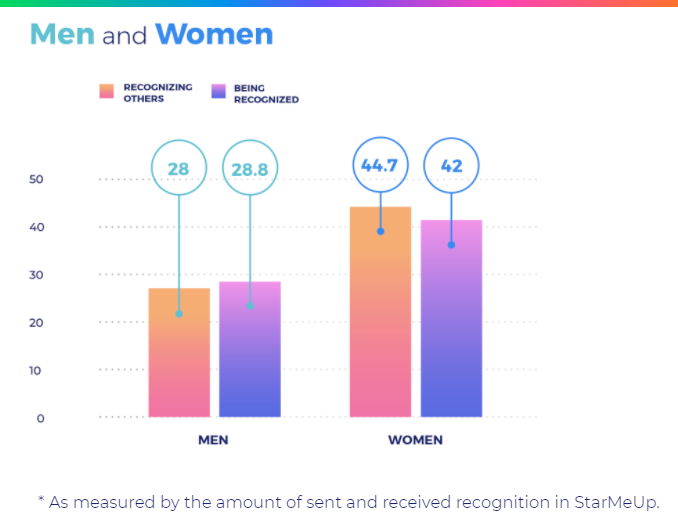
Another challenge for women in technology is staying in management positions once they have reached those levels. This is why we also wanted to look at the women most visible from the executive lens.
In evaluating the distribution of roles across a wide spectrum, we see the “bell curve” below. We used this as the foundation.

Both men and women in executive positions recognize those in their peer group proportionately more than those in the other levels. However, women executives give other women in entry-level jobs more visibility than their male peers do. Men, on the other hand, recognize women at the mid-level more. It’s hard to say what these numbers would look like without StarMeUp because Globant has been using it for so many years but in a global company without technology helping to increase employee visibility across the organization, the numbers would likely skew toward executives building relationships with their peer executive group much more. With this data from StarMeUp, we measure and track how the various initiatives and efforts to give women visibility across the different levels are working and adjust and enhance them as necessary.

The tale of two cultures: Organizational and Societal
How much of an impact does the country a person lives in or the culture they were born into have on the way they connect with others? Can that be “overridden” by company culture? Should it be?
When we looked at the relationship data by each country where Globant operates, we found similar patterns, in particular, that women had more extensive networks than men. The exception was India, where the average number of connections was similar between men and women.
Average connections of men and women by country
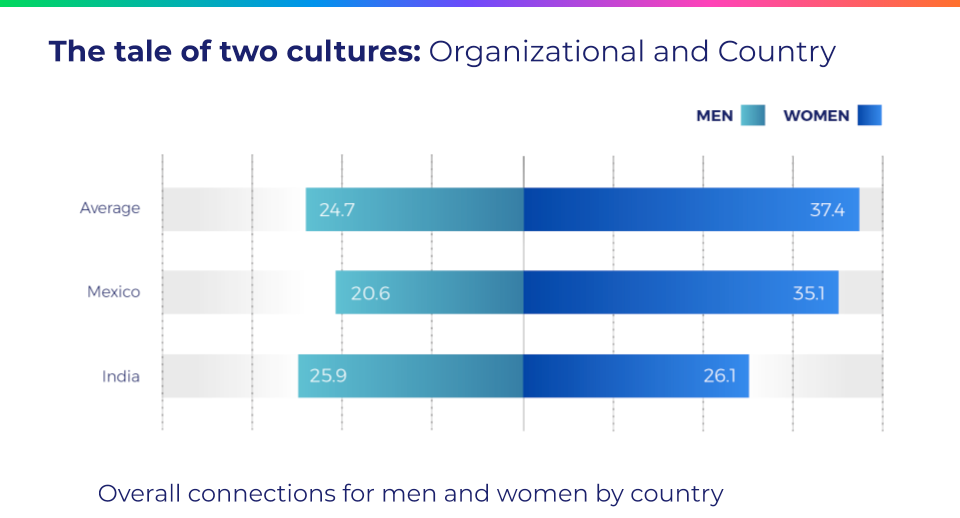
The pattern in India intrigued us so we decided to check the dynamics of the interactions between men and women to make sure that the fewer relationships on average compared to other Globant countries weren’t the result of gender silos.
Looking at the organizational network analysis (ONA), we were able to confirm that although there was a difference in the average number of colleagues that women in India connected with compared to Mexico (which was closer to the overall company averages), Globant had an inclusive culture without any gender silos in both countries. Moreover, it was encouraging to see women as key connectors at the center in India and Mexico alike.
Connectivity between men and women in two different countries
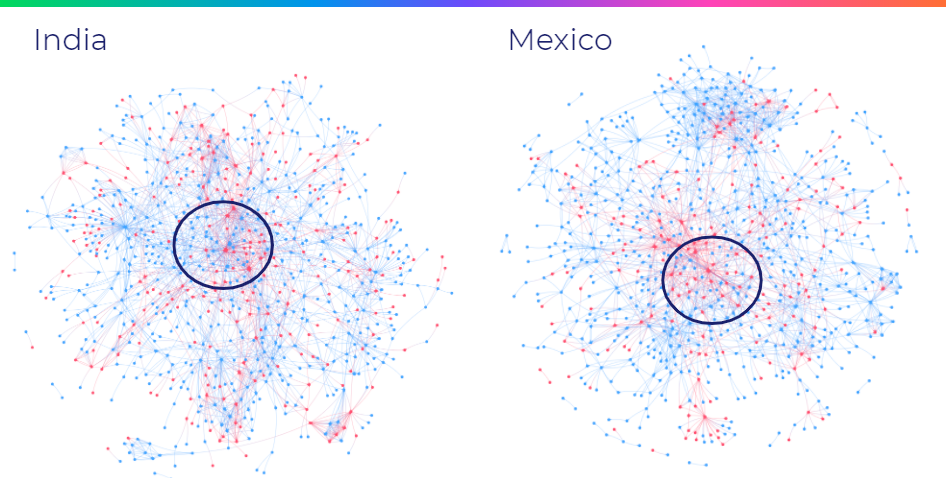
Although technology can greatly help foster and measure an inclusive environment, it’s important to draw attention to the people who live and breathe the organization’s culture every day. At Globant this is our People Business Partner team. For this reason, when we zoomed in on the center of the Mexico ONA, we saw that the red dot was a member of this People team. And when we looked at the connectivity of that team alone, we got a heart-shaped ONA. When you get this kind of output, you know you are doing something right with your culture.
Mexico People BP Team
